InterviewSolution
Saved Bookmarks
This section includes InterviewSolutions, each offering curated multiple-choice questions to sharpen your knowledge and support exam preparation. Choose a topic below to get started.
| 2051. |
From the following information, calculate the amount of subscriptions to be credited to the Income and Expenditure Account for the year 2017-18: {:(,Rs),("Subscriptions received during the year","60,000"),("Subscriptions outstanding on 31st March, 2017","16,000"),("Subscriptions outstanding on 31st March, 2018","9,000"),("Subscriptions received in advance on 31st March, 2017","12,000"),("Subscriptions received in advance on 31st March, 2018","7,000"),("Subscriptions of Rs6,000 are still in arrears for the year" 2016-17,):} |
| Answer» Solution :`{:("Amount of Subscription to be Credited to Income and Expenditure Account ",Rs,Rs),("SUBSCRIPTIONS RECEIVED during the YEAR",,"60,00"),("Add: Subscriptions received in advance on 31ST MARCH,2017","12,000",),("Subscriptions outstanding on 31st March,2018",underline("9,000"),underline "21,000"),(,,"81,000"),("Less, Subscriptions outstanding on 31st March, 2017","16,000",),("Subscriptions received in advance on 31st March, 2018","7,000","23,000"),("Subscriptions to be Credited to Income and Expenditure Account",,underline underline overline ("58,000")):}` | |
| 2052. |
From the following information, calculate the amount of subscriptions outstanding for the year 2017-18: A club has 250 members each paying an annual subscription of Rs.1,000. The Receipts and Payments Account for the year showed a sum of Rs.2,65,000 received as subscriptions. The following additional information is provided: {:(,Rs),("Subscription outstanding on 31st March,2017","40,000"),("Subscriptions recived in advance on 31st March, 2018","30,000"),("Subscription received in advance on 31st March,2017","12,000"):} |
Answer» Solution :`{:("Calculation of subscriptions OUTSTANDING for the year 2017-18:",,RS),("Subscriptions received during the year" (2017-18),,"2,65,00"),("ADD: Subscriptions received for the year" (2017-18),, underline ("12,000")),(,,"2,77,000"),("Less: Subscriptions received in advance on 31ST MARCH, 2018","30,000",),("Subscriptions received for 2016-17",underline("40,000"),underline ("70,000")),("Subscriptions received for the year 2017-18",,underline underline overline ("2,07,000(A)")),("Total Subscriptions due for the year 2017-18(250 membersxRs 1,000)",,"2,50,000(B)"),("Subscriptions outstanding for the year" 2017-18 (B-A),,),("i.e.,(2,50,000-Rs 2,27,000)",,"43,000"):}` 
|
|
| 2053. |
From the following information, calculate the amount of sports meterial to be debited to the Income and Expenditure Account of a Sport Club for the year ended 31st March, 2018 {:(,Rs.),("Balance of Sport Material as on 1st April,2017","20,000"),("Balance of Sport Material on 31st March,2018","15,000"),("Creditors for Sports Material as on 1st April, 2017","40,000"),("Creditors for Sports Material as on 31st March, 2018","45,000"),("Payment made for Sports material Creditors during the year ended",),("31st March,2018","2,00,000"):} |
Answer» SOLUTION : SPORTS MATERIAL purchased during the yrar Rs.2,05,000. Amount of sports material to be debited to INCOME and Expenditure ACCOUNT Rs.2,10,000. |
|
| 2054. |
From the following information, calculate the amount of medicines to be debited to the Income and Expenditure Account of National Hospital for the year ended 31st March, 2018: {:(,Rs.),("Stock of medicines on 1st April, 2017","3,69,00"),("Stock of medicines on 31st March, 2018","3,69,000"),("Creditors for medicines on 1st April, 2017","17,85,000"),("Creditors for medicines on 31st March, 2018","19,37,000"),("Paid to creditors for medicines during the year ended 31st year ended 31st March,2018","20,00,000"):} |
| Answer» SOLUTION :Amount of MEDICINES Consumed to be debited to Income and EXPENDITURE ACCOUNT Rs.20,30,000. PURCHASE of Medicines Rs.21,52,000. | |
| 2055. |
From the following information, Calculate Proprietary Ratio: Share Capital Rs 5,00,000, Non-Current Assets Rs 22,00,000 Reserves and Surplus Rs 3,00,000 Current Assets Rs 10,00,000 |
|
Answer» 1 |
|
| 2056. |
From the following information, calculate Proprietary Ratio, Debt to Equity Ratio and Total Assets to Debt Ratio: Non-current Assets Rs 4000000, Current Assets Rs 4000000, Long-term Borrowings Rs 2500000, Long-term Provisions Rs 1500000, Current Liabilities Rs2000000. |
|
Answer» Solution :Debt =Long-term Borrowings+Longs -term PROVISIONS =RS 2500000+Rs 1500000=Rs 4000000 Total Assets =Non -CURRENT Assets +Current Assets =Rs 4000000+ Rs 4000000=Rs 8000000. PROPRIETORS's FUNDS/Equityt=Total Assets-Non-Current Liabilities-Current Liabilities =Rs 8000000-Rs 4000000-Rs 2000000=Rs 2000000 Proprietary Ratio =`("Proprietors's funds")/("Total Assets")xx10=(Rs 2000000)/(Rs 8000000)xx100=25%` Debt To Equity Raito =`("Debt)/(Equity")=(Rs 4000000)/(Rs 2000000)=2:1` Total Assets to Debt Ratio =`("Total Assets")/("Debt")=(Rs 8000000)/(Rs 4000000)=2:1` |
|
| 2057. |
From the following information, calculate proprietary Ratio: |
Answer» Solution :PROPRIETARY Ratio =`("Shareholders'Funds")/("TOTAL ASSETS")=(Rs 175000(NOTE))/(Rs 250000)=0.7:1` 
|
|
| 2058. |
From the followinginformation ,calculate Net cash Flow from OperatingActivitied and Financing Activities: Additional Information: 1. Duringthe year additionaldebentureswere issued at par on 1st October and Bank Loan was repaid on the samedate. 2. Dividend on Equity Share @ 8% was paid on Opening Balance. 3. Income tax ₹ 1,12,500 has beenprovided duringthe years. 4. Perference Shares were redeemed at par at theendof the years. |
|
Answer» Cash Flow form FINANCING Activities = ₹ 97,500. |
|
| 2059. |
From the following information, calculate Proprietary Ratio: |
| Answer» SOLUTION :Proprietary Ratio =`("Proprietors'Funds")/("TOTAL ASSETS")xx10=(RS 2000000)/(Rs 8000000)xx10=25%` | |
| 2060. |
Fromthe following information, calculate inventorey turnover Ratio ,Rs Cost of Revenue from operations (Cost of goods sold), 450000 Inventories in the beginning of the year, 100000 Inventories at the end of the year, 125000 |
|
Answer» SOLUTION :Inventory TURNOVER Ratio =`("Cost of Revenue from operations")/("Average Inventorty")=(RS 450000)/(Rs 112500)=4Times` Average Inventory =`("opening Inventory +CLOSING Inventory")/(2)` `=(Rs 100000+Rs 125000)/(2)=Rs 112500` |
|
| 2061. |
From the following information calculate Inventory Turnover Ratio:Revenue from Operation Rs. 16,00,000, Average Inventory Rs. 2,20,000, Gross Loss Ratio 5%. |
|
Answer» Solution :Inventory Turnover RATIO = `("Cost of REVENUE from Operations")/("AVERAGE Inventory")` `= (Rs. 16,80,000)/(Rs. 2,20,000)` = 7.64 Times. Working NOTE: Cost of Revenue from Operations = Revenue from Operations + Gross LOSS = Rs. 16,00,000 + Rs. 80,000 (i.e., 5% of Rs. 16,00,000) = Rs. 16,80,000. |
|
| 2062. |
From the following information, calculate Change in inventory of Work-in Progress: Opening and Closing Work-in-Progress Rs 1,50,000 and Rs 1,45,000 respecitvely. |
|
Answer» |
|
| 2063. |
From the following information, calculate Change in inventory of Work-in-Progress: Opening and Closing Work-in-Progress Rs 1,00,000 and Rs 1,15,000 respectively. |
|
Answer» |
|
| 2064. |
From the following information, calculate Change in Inventory of Finished Goods: Opening Inventory and Closing Inventory of Finished Goods Rs 2,50,000 and Rs 2,00,000 respectively. |
|
Answer» |
|
| 2065. |
From the following information, calculate Change in Inventory of Finished Goods: Opening Inventory and Closing Inventory of Finished Goods Rs 2,00,000 and Rs 1,75,000 respectively. |
|
Answer» |
|
| 2066. |
From the following information, calculate Cash Flow from Operating Activities:(i) A piece of machinery costing Rs. 50,000 on which depreciation of Rs. 20,000 had been charged was sold for Rs. 10,000. Depreciation charged during the year was Rs. 18,000.(ii) Income Tax Rs. 23,000 was paid during the year.(iii) Dividend paid during the year was Rs. 36,000. |
Answer» Solution : WORKING Note: `{:("Calculation of Net Profit before TAX and Extraordinary Items: ",,"Rs"),("Surplus (i.e., Balance in the STATEMENT of Profit and LOSS as on 31st March, 2015)",,"71,000"),("Less: Surplus (i.e., Balance in the Statement of Profit and Loss as on 31st March, 2014)",,ul("89,000")),("Net Loss during the year",,("18,000")),("Add: Dividend Paid","36,000",),("Tax paid",ul("23,000"),ul("59,000")),("Net Profit before Tax and Extraordinary Items",,ulul("41,000")):}` |
|
| 2067. |
From the following information, calculate any two of the following ratios:(i) Liquid Ratio,(ii) Gross Profit Ratio,(iii) Debt to Equity Ratio.information:Revenue from Operation, Rs. 4,00,000, Opening Inventory Rs. 10,000, Closing Inventory Rs. 3,000 less than Opening Inventory, Net Purchases 80% of Revenue from Operations,Direct Expenses Rs. 20,000, Current Assets Rs. 1,00,000, Prepaid Expenses Rs. 3,000, Current Liabilities Rs. 60,000, 9% Debentures Rs. 4,00,000, Long-term Loan from Bank Rs. 1,50,000, Equity Share Capital Rs. 8,00,000, 8% Preference Share Capital Rs. 3,00,000. |
|
Answer» Solution :(i) Liquid Ratio = 1.5 : 1, (ii) Gross Profit Ratio = 14.25%, Gross Profit = Rs. 57,000, Debt to Equity Ratio = 0.5 : 1. Working Note: Long-term DEBTS = 9% Debentures + Loan from BANK = Rs. 5,50,000, SHAREHOLDER's Funds = Equity SHARE Capital + 8% Preference Share Capital = Rs 11,00,000, Cost of Revenue from Operations = Rs. 3,43,000, Gorss Profit = Rs. 57,000. |
|
| 2068. |
From the following information, calculate any two of the following ratios:(a) Debt to Equity Ratio,(b) working Capital Turnover Ratio,(c ) Return on Investment.Information: Equity Share Capital Rs. 50,000, General Reserve Rs. 1,00,000, Statement of Profit and Loss (Profit after Tax and Interest) Rs. 3,00,000, 12% Debentures Rs. 4,00,000, Creditors Rs. 3,00,000, Land and Building Rs. 14,00,000, Furniture Rs. 3,00,000, Debtors Rs. 2,90,000, Cash Rs. 1,10,000.Revenue from Operation (Net Sales) forthe year ended 31st March, 2011 was Rs. 30,00,000 and Tax paid 50%. |
|
Answer» Solution :(a) Debt of Equity Ratio = 0.29 : 1,(B) Working Capital Turnover Ratio = 30 Times,(c ) ROI = 36%. Working Notes: For Debt to Equity Ratio 1. Debt = 12% Debentures = Rs. 4,00,000. 2. Equity = Equity Share Capital + General Reserve + Statement of PROFIT and Loss = Rs. 10,00,000 + 1,00,000 + Rs. 3,00,000 = Rs. 14,00,000. For Working Capital Turnover Ratio Working Capital = Rs. 4,00,000 (C.A) - Rs. 3,00,000 (C.L) = Rs. 1,00,000. For Return on Investment 1. Profit before Tax = `("Profit before Tax"xx 100)/("100-Tax Rate") = (Rs. 3,00,000 xx 100)/(100-50)` = Rs. 6,00,000. 2. Profit before Interest and Tax = Rs. 6,00,000 + Rs. 48,000 (Interest on Debentures) = Rs. 6,48,000. 3. Capital Employed = Equity Share Capital + General Reserve + Statement of Profit and Loss + 12% Debentures = Rs. 10,00,000 + Rs. 1,00,000 + Rs. 3,00,000 + Rs. 4,00,000 = Rs. 18,00,000. Or Capital Employed = Non-Current Assets + Working Capital = Rs. 17,00,000 + Rs. 1,00,000 = Rs. 18,00,000 Non-Current Assets = Land and Building + FURNITURE = Rs. 14,00,000 + 3,00,000 = Rs. 17,00,000. |
|
| 2069. |
From the following information, calculate any two of the following ratios:(a) Debt to Equity Ratio,(b) working Capital Turnover Ratio,(c ) Return on Investment.Information: Equity Share Capital Rs. 5,50,000, General Reserve Rs. 50,000, Statement of Profit and Loss (Profit after Tax and Interest) Rs. 1,00,000, 9% Debentures Rs. 2,00,000, current Rs. 1,00,000, Land and Building Rs. 6,50,000, Equipments Rs. 1,50,000, Debtors Rs. 1,45,000, Cash Rs. 55,000. Revenue from Operation (Net Sales) for the year ended 31st March, 2011 was Rs. 15,00,000 and Tax Paid 50%. |
|
Answer» SOLUTION :(a) Debt to Equity Ratio = 0.29 : 1, Working Capital Turnover Ratio = 15 Times, (C ) Return on Investment = 24.22%.Working NOTE: Net Profit before INTEREST and Tax = Rs. 2,18,000 (Rs 1,00,000 `xx (10)/(50) +` Rs. 18,000) Capital Employed = Rs. 9,00,000, Debt = Rs. 2,00,000, Equity = Rs. 7,00,000. |
|
| 2070. |
From the following information, calculate any two of the following ratios:(a) Debt to Equity Ratio,(b) working Capital Turnover Ratio,(c ) Return on Investment.Information: Equity Share Capital Rs. 50,000, General Reserve Rs. 5,000, Statement of Profit and Loss (Pofit after Interest and Tax) Rs. 15,000, 9% Debentures Rs. 20,000, Creditors Rs. 15,000, Land and Building Rs. 65,000, Equipments Rs. 15,000, Debtors Rs. 14,500 and Cash Rs. 5,500.Sales for the year ended 31st March, 2011 was Rs. 1,50,000. Tax rate 50%. |
|
Answer» Working Notes: 1.Debt = 9% Debentures = Rs. 20,000. 2. Equity = Equity Share Capital + General Reserve + Statement of Profit and Loss (Profit after Interest and TAX) = Rs. 50,000 + Rs. 5,000 + Rs. 15,000 = Rs. 70,000. (b) Working Capital Turnover Ratio = `("Revenue from Operation (Net Sales)")/("Working Capital")` `= (Rs. 1,50,000)/(Rs. 5,000)` = 30 Times. Working Note: Working Capital = Current Assets - Current Liabilities = Rs. 20,000 - Rs. 15,000 = Rs. 5,000. Current Assets = Debtors + Cash = Rs. 14,500 + Rs. 5,500 = Rs. 20,000. Current Liabilities = Creditors = Rs. 15,000. (c ) Return on Investment = `("Profit before Interest and Tax")/("Capital Employed") xx 100` `= (Rs. 31,800)/(Rs. 90,000) xx 100 = 35.33%`. Working Notes: 1.Profit before tax = `("Profit after Tax"xx 100)/(100 - "Tax RATE")` ` = (Rs. 15,000 xx 100)/(100-50)=(15,000 xx 100)/(50) = Rs. 30,000` Profit before interest and Tax = Rs. 30,000 + Rs. 1,800 (Interest on Debentures) Rs. 31,800. 2. Capital Employed = Equity Share Capital + General Reserve + Statementof Profit and Loss (Profit after Interest and Tax) + 9% Debentures = Rs. 50,000 + Rs. 5,000 + Rs. 15,000 + Rs. 20,000 = Rs. 90,000. |
|
| 2071. |
From the following information , calcualte Debt to Equity Rtio, Proprietary Ratio and Total assets to Debt Ratio: |
|
Answer» SOLUTION :Debt to Equity RATIO=`("Debt")/("Equity")=(RS 1600000)/(Rs 900000)=1.78:1` Proprietary Ratio =`("Shareholders' Fuds")/("Total Assets")=(Rs 900000(WN 1))/(Rs 3180000)=0.28:1` Total Assets to Debt Ratio=`("Total Assets")/("Debt")=(Rs 3180000(WN 3))/(Rs 1600000(WN 4))=1.99:1` 
|
|
| 2072. |
From the following information calcualate Inventory Turnover Ratio:, Rs Revenue from operation , 500000 Inventory: Opening , 75000 Inventorey: opening , 125000 closing |
|
Answer» Solution :Inventory TURNOVER Ratio =`("REVENUE form operations")/("Average Inventory")=(Rs 500000)/(Rs 10000)=5 Times` `"Average Inventory"=(Rs 75000+Rs 125000)/(2)=Rs 100000` |
|
| 2073. |
From the following informatin of a Non-for-Profit Organisation, show the Sports Material items in the Income and Expenditure Account for the year ended 31st March, 2018 and the Balance Sheets as at 31at March, 2017 and 31st March, 2018: {:(,"31st March, 2017(Rs)","31st March, 2018 (Rs)"),("Stock of sports material","7,800","5,800"),("Stock of sports material","7,800","9,200"),("Advance to suppliers for sports material","15,000","25,000"):} Payment to suppliers for the sports material during the year was Rs.1,20,000. There were no cash purchase made. |
Answer» Solution : `{:("Cslculation of SPORT Material Used:",Rs.),("Opening Stock","2,200"),("ADD: Purchase (WN1)",UNDERLINE ("1,11,400")),(,"1,13,600"),("Less: Closing Stock","5,800"),("Sports Material Used",underline underline overline("1,07,800")):}` Note: Alternatively, Stock of Sport Material may be prepared to CALCULATE Sports Material Used during the year. |
|
| 2074. |
From the following Informatio, calculate Change in inventory of Stock-in-Trade: Opening and Closing Stcok-in-Trade Rs 5,00,000 and Rs 4,00,000 respectively. |
|
Answer» |
|
| 2075. |
From the following extract of Receipt and Payment Account and the additional information, compute the amount of income from subscriptions and show as how they would appear in the Income and Expenditure Account for the year ending March 31, 2015 and the Balance Sheet. Receipt and Payment Account for the year ending March 31, 2015 Additional Information: |
|
Answer» Solution :Income and Expenditure Account for the year ending on MARCH 31, 2015  Note: Total amount of subscriptions outstanding as on 31-3-2015 are RS. 18,500. This, includes Rs. 1,500 (Rs. 8,500 – Rs. 7,000) for subscriptions still outstanding for 2013–14. Hence, the subscriptions outstanding for 2014–15 are Rs. 17,000 (Rs. 18,500 – Rs. 1,500). BALANCE Sheet (RELEVANT Data) as onMarch 31, 2015  *Relevant data only |
|
| 2076. |
From the following extracts taken from the Balance Sheets of M/s. KhandujaLtd., on 31st March and the additional information provided, you are required to calculate: (i) Cash Flow from Operating Activities. (ii) Cash Flow from Financing Activities.Additional Information:Preference Shares were redeemed on 31st March, 2005 at a premium of 5%. Dividend on Equity Shares was paid @ 8%. Fresh issue of Equity Shares was done on 1st April. 2004. |
Answer» SOLUTION :
|
|
| 2077. |
From the following details, calculate Opening Inventory:Closing Inventory Rs. 60,000, Total Revenue from Operations Rs. 5,00,000 (including cash revenue from operations Rs. 1,00,000), Total purchases Rs. 3,00,000 (including credit purchases Rs. 60,000). Goods are sold at a profit of 25% on cost. |
|
Answer» Solution :Total Revenue from Operations = RS. 5,00,000 Gross PROFIT = `(1)/(4)` on Cost = `(1)/(5)` on Sales* `= (1)/(5) xx` Rs. 5,00,000 = Rs. 1,00,000 Cost of Revenue from Operations = Net Revenue from Operations - Gross Profit = Rs. 5,00,000 - Rs. 1,00,000 = Rs. 4,00,000 Cost of Revenue from Operations = Opening Inventory + Net PURCHASES - Closing inventory Rs. 4,00,000 = Opening Inventory + Rs. 3,00,000 - Rs. 60,000 Opening Inventory = Rs. 1,60,000. *LET Cost = Rs. 100, Gross Profit= Rs. 25, Revenue from Operations (Sales) = Rs. 125, Gross Cost = Rs.25/Rs.100 = 1/4 on Cost or Gross Profit on Sales = Rs. 25/Rs.125 = 1/5 on Sales. |
|
| 2078. |
From the following details obtained from the financial statement of Jeev Ltd, calculate Interest coverage Ratio: Net Profit after Tax, Rs 120000 12% Long-term Debt, Rs 2000000 Tax Rate,40% |
|
Answer» Solution :Interest Coverage Ratio =`("Net Profit before Interest And Tax")/("Interest on Long-term Debt")` `=(RS 440000)/(Rs 240000)=1.83 Times` Interest on Long-term DEBTS =12% of Rs 200000=Rs 240000 CALCULATION of Net Profit befoe Interest and Tax: Net Profit after Tax =Rs 120000 Let, Net Profit before Tax =Rs 100,Tax=Rs 40, Net Profit after Tax =Rs 60 Net Profit before Tax =`Rs 120000xx(Rs 100)/(Rs 60)=Rs 20000` Net Profit before Interest and Tax =Net Profit before Tax + Interest on Long-term Debts =Rs 20000+Rs 240000=Rs 440000. Net Profit before Tax shown Net Profit after Interest by before Tax. |
|
| 2079. |
From the following data, calculate inventory Turnover Ratio : Cost of Revenue from operations (Cost of Goods Sold)Rs 300000, Purchases Rs 330000, opening inventory Rs 60000. |
|
Answer» Solution :Inventory Turnover Ratio =`("Cost of REVENUE from operations")/("Average Inventroy")=(Rs 300000)/(Rs 75000)= 4 Times` Cost of Revenue from operations(Cost of Goods SOLD) =opening Inventory +Purchases + Direct Expenses -closing Inventory Closing Inventory =Opening Inventory+ Inventory+ Purchses -Cost of Revenue From OPERTIONS (Cost of Goods sold) =Rs 60000+Rs 330000-Rs 300000=Rs 90000 Average Inventory `=("Opening Inventory+Closing Inventroy")/(2)` `=(Rs 60000+Rs 90000)/(2)=Rs 75000` |
|
| 2080. |
From the following calculate the 'Gross Profit Ratio' and 'Working Capital Turnover Ratio':{:(,Rs),("Revenue from Operations","30,00,000"),("Current Assets","6,00,000"),("Paid-up Share Capital","5,00,000"):}:|{:(,Rs),("Cost of Revenue from Operations","20,00,000"),("Current Liabilities","2,00,000"):} |
|
Answer» Solution :Gross Profit Ratio = `("Gross Profit")/("Revenue from Operations") = (RS. 10,00,000)/(Rs. 30,00,000) xx 100 = 33(1)/(3)%`. Working Capital Turnover Ratio = `("Revenue from Operations")/("Working Capital") = (Rs. 30,00,000)/(Rs. 4,00,000)` = 7.5 Times. Working Notes: 1. Gross Profit = Revenue from Operations - COST of Revenue from Operations = Rs. 10,00,000. 2.Working Capital = Current ASSETS - Current LIABILITIES = Rs. 4,00,000. |
|
| 2081. |
From the following, calculate:(a) Operating Profit Ratio, and (b) Working Capital Turnover Ratio.{:(,"Rs"),("Revenue from Operations","2,00,000"),("Office Expenses","15,000"),("Interest on Debentures","5,000"),("Income from Rent","2,500"),("Current Assets","60,000"):}:|{:(,"Rs"),("Gross Profit","75,000"),("Selling Expenses","26,000"),("Accidental Losses","12,000"),("Commission Received","2,000"),("Current Liabilities","10,000"):} |
|
Answer» SOLUTION :(a) Operating Profit Ratio = `("Operating Profit")/("REVENUE from Operations")XX100 = ("RS. 34,000")/("Rs. 2,00,000")xx100` (b) Working Capital Turnover Ratio = `("Revenue from Operations")/("Working Capital") = ("Rs. 2,00,000")/("Rs. 50,000")` = 4 Times. Working Notes: 1. Operating Profit = Gross Profit - Operating Expenses (i.e., Office Expenses + Selling Expenses) = Rs. 34,000. 2.Working Capital = Current Assets - Current Liabilities = Rs. 50,000. |
|
| 2082. |
From the following, calculate:(a) Current Ratio, and (b) working Capital Turnover Ratio.{:(,"Rs"),("Revenuefrom Operations","1,50,000"),("Shareholders' Funds","60,000"),("Non-current Assets","50,000"):}:|{:(,"Rs"),("Total Assets","1,00,000"),("Non-current Liabilities","20,000"):} |
|
Answer» SOLUTION :(a) Current Ratio = `("Current Assets")/("Current Liabilities")=("RS. 50,000")/("Rs. 20,000")=2.5 : 1` Working Notes: 1. Current Assets = Total Assets - Non-current Assets = Rs. 1,00,000 - Rs. 50,000 = Rs. 50,000. 2. Current Liabilities = Total Assets - Shareholders' Funds - Non-current Liabilities = Rs. 1,00,000 - Rs. 60,000 - Rs. 20,000 = Rs. 20,000. (B) Working Capital Turnover Ratio = `("Revenue from Operations")/("Working Capital")` `=("Rs. 1,50,000")/(30,000)` = 5 Times. Working Note: Working Capital = Current Assets - current Liabilities = Rs. 50,000 - Rs. 20,000 = Rs. 30,000. |
|
| 2083. |
From the following Balance Sheets of Vijaya Ltd. As at 31st March, 2013, prepare Cash Flow Statement:Additional Information: 1. Depreciation on Fixed Assets for the year 2012-2013 was Rs. 14,700.2. An interim dividend Rs. 7,000 has been paid to the shareholders during the year. |
Answer» Solution : WORKING Notes: `{:("1. Calculation of Net Profit before Tax and Extraordinary Items: ","Rs."),("Net Profit as per STATEMENT of Profit and LOSS (Rs. 15,000 - Rs. 9,000)","6,000"),("ADD: Transfer to General Reserve","12,500"),("Interim Dividend paid during the YEAR",ul("7,000")),("Net Profit before Tax and Extraordinary Items",ulul("25,500")):}` 
|
|
| 2084. |
From the followingBalance sheets of New LightLtd. As at 31st March, 2019 and the additional infornation, determineCash Flow fromInvesting Activites: Additional Information : Duringthe years, the company soldmachinery at book value of ₹ 2,00,000. |
Answer» SOLUTION :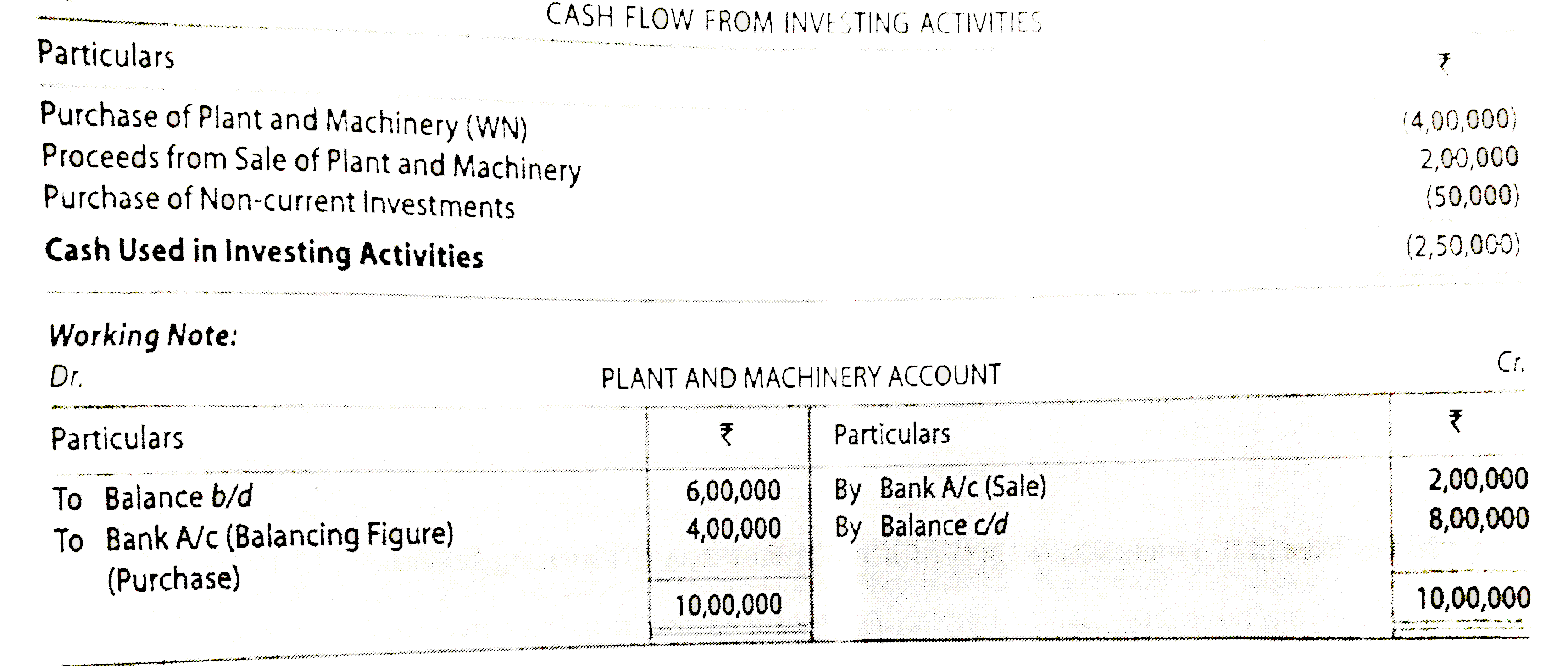
|
|
| 2085. |
From the following Balance Sheets of Amrit Limited as at March 31, 2016 and 2017, prepare a comparative balance sheet: |
|
Answer» SOLUTION :COMPARATIVE Balance Sheet of Amrit LIMITED as at March 31, 2016 and March 31, 2017 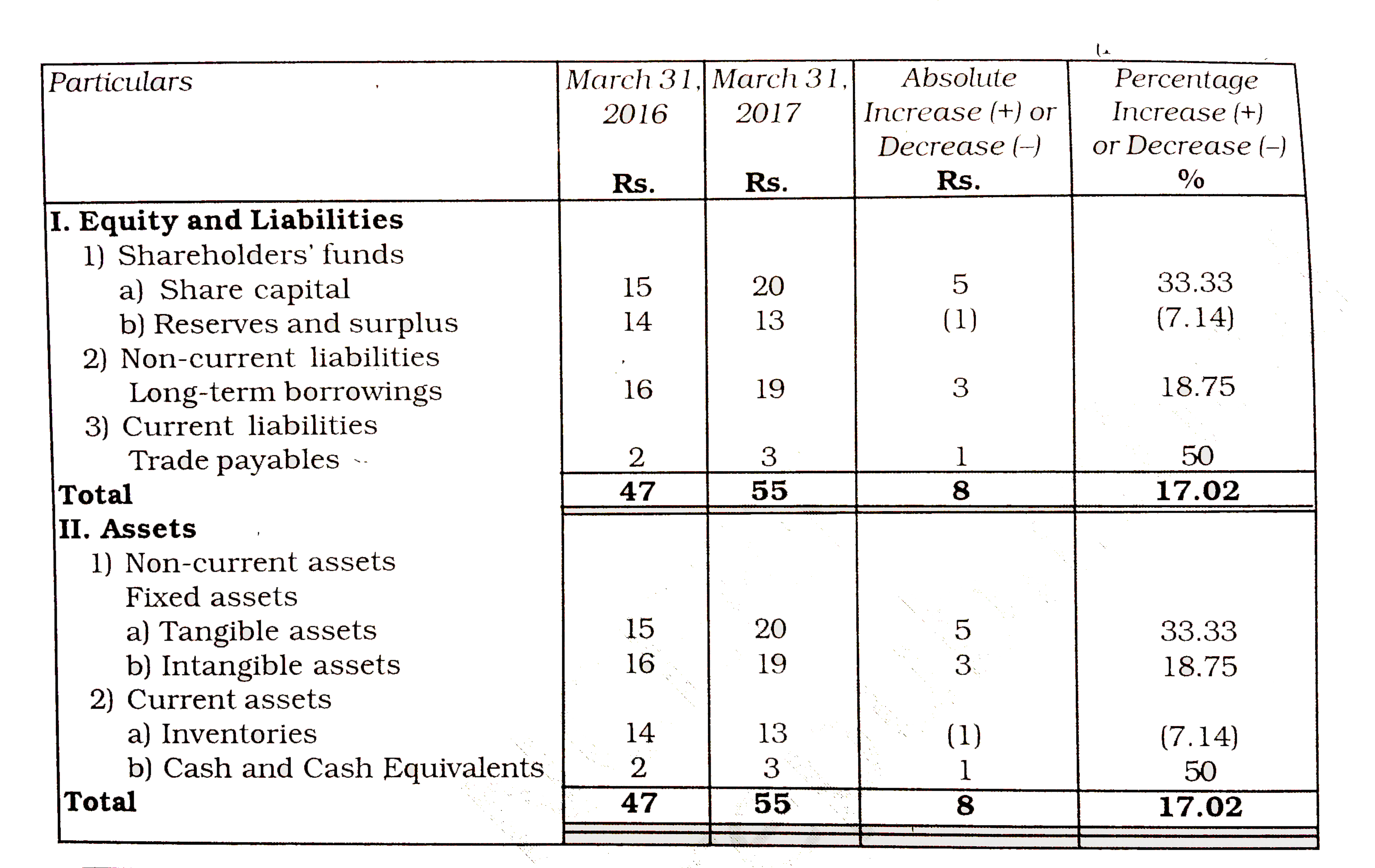
|
|
| 2086. |
From the followingBalanceSheetof Young's India Ltd.,perpare Cash Flow Statement : |
|
Answer» |
|
| 2087. |
Fromthe followingBalance sheetof X and YCalculateintereston capital @ 5%p.a for theyearended31 stMarch 2019: Duringthe yearended31st March2019 X. Drawings WereRs. 10.000 Y' s Drawings wereRs. 30.000profitforthe yearended31stMarch. 2019 wasRs. 60,000theamountOfResrve i.e.,Rs. 40,000is transferredfromCurrect Year 'sProfittostrengthen thedinancial position of the firm |
|
Answer» Solution :`{:("Calculation of interest on x's capital :",Rs.),("X's Capital as at 31ST March,2019",90.000),("add: Drawings made during the year",10.000),(,overline(1.00.000)),("LESS: PROFIT (added or credited)[1/2(rs.60.000-Rs.40.000])",10.000),("capital as at 1stApril,2018",underline overline(90.000)),("interest on capital @5% p.a =Rs. =90.000"xx5//100=Rs.4.500.,),("calaulationof intereston Y'sCapital :",Rs.),("Y's capital as at31stMarch .2019",80.000),("add:Drawings made durings theyear ",30.000),(,overline(1.10.000)),("Less: Profit (added or credited)[1/2(Rs.60.000-rs.40.000)]",10.000),("capials a at 1st April .2018",underline overline(1.00.000)),("interest on capital@5% p.a =Rs. 1.00.000"xx5//100=Rs.5.000.,):}` note: 1.capitalin thebeging iscalcuatedbyaddingdrawigs deductingprofit distributed . 2.Profitduringthe wasRs. 60.000outof whichRs. 40.000is TRANSFERRED toReserve and isshownin theBalancesheetthus in EFFECT onlyRs, 20,000weredistributedwhichhavebeendeducted. 3.in theabsenceof anyprofit- sharing ratiobeing, parners willshare profitand lossequally . |
|
| 2088. |
From the following Balance Sheet of Vijaya Ltd. As at 31st March, 2013, prepare Cash Flow Statement:Note to AccountsAdditional Information:1. Depreciation charged on fixed assets for the year 2012-2013 was Rs. 20,000.2. Income Tax Rs. 5,000 has been paid in advance during the year. |
|
Answer» Solution :CASH FLOW from OPERATING ACTIVITIES = Rs. 54,600. Cash Used in Investing Activities = Rs. 92,600. Cash Flow Financing Activities = Rs. 40,000. NET Increase in Cash and Cash Equivalents = Rs. 2,000. |
|
| 2089. |
fromthe followingBalance sheetof longandshort, calculateintereston capital@8%p.a for the year ended31st March , 2019: duringthe yearlongwirthdrew Rs. 40,000and shortwithdrewRs. 50,000profit for theyearwas Rs. 1,50,000outof whichRs. 1,00,000wastensferredto generalReserve . |
|
Answer» |
|
| 2090. |
From the following Balance Sheet of L.M.R. Ltd. As at 31st March, 2018, prepare Cash Flow Statement:Notes to AccountsAdditional Information:1. Proposed dividend for the year ended 31st March, 2017 was Rs. 35,000 and for the year ended 31st March, 2018, it was Rs. 70,000.2. During the year equipment costing Rs. 50,000 was purchased Loss on Sale of Equipment amounted to Rs. 6,000. Rs. 9,000 depreciation was charged on equipment. |
| Answer» Solution :`{:(,"Rs."),("CASH FLOW from Operating ACTIVITIES","76,000"),("Cash Used in INVESTING Activities","62,500"),("Cash Flow from Financing Activities",ul"40,000"),("NET Increase in Cash and Cash Equivalents",ul"14,25,00"):}` | |
| 2091. |
Fromthe followingBalance Sheet of KumarLtd., as31st Marach, 2019, prepare Cash Flow Statement: Additional Information: 1. Duringthe year, a machinerycosting ₹ 20,000 was sold ₹ 6,000. 2. Dividend paidduring theyears ₹ 50,000. |
|
Answer» |
|
| 2092. |
From the following Balance Sheet of JY Ltd. As at 31st March 2017, prepare a Cash Flow Statement:Notes to AccountsNote: Proposed Dividend for the years ended 31st March, 2016 and 2017 are Rs. 50,000 and Rs. 75,000 respectively.Additional Information: Rs. 1,00,000, 10% Debentures were issued on 31st March, 2017. This question is amended to comply with Accounting Standard 4 (Revised), Contingencies and Events Occurring After the Balance Sheet Date. |
Answer» Solution : Working Notes: `{:("1. Calculation of Net Profit before Tax and Extraordinary Items:","Rs."),("Net Profit for the year (Rs. 1,00,000 + Rs. 25,000)","1,25,000"),("Add: Proposed DIVIDEND (for 2016-17) paid during the year (WN-2)"," 50,000"),("Provision for Tax (2017-18)",ul"1,25,000"),(,ulul"30,00,000"):}` 2. Dividend proposed by the Board of Director's for a particular Accounting year is not a liability unless the same is approved by the shareholders in the Annual General Meeting (AGM). Therefore, the REVISED AS-4, CONTINGENCIES and Events OCCURRING after the Balance Sheet Date, that proposed dividend declared is not to be recognised as a liability at the Balance Sheet Date. It should be disclosed in the Notes to Accounts. In the next year, when such proposed dividend is declared in the AGM, following entries are passed and declared dividend is paid: `{:("Surplus,i.e.,Balance In Statement of Profit and Loss" ....Dr.),(ul("""To Dividend Payable A/c""")),("Divident Payable A/c"),("""To Bank A/c"""....Dr.):}` If should be noted that Current year's proposed dividend will not be CONSIDERED while preparing Cash Flow Statement. |
|
| 2093. |
From the following balance sheet of cpt ltd as at 31st march 2019 prepare a comparative balance sheet and also compute debt toequity ratio: |
Answer» Solution :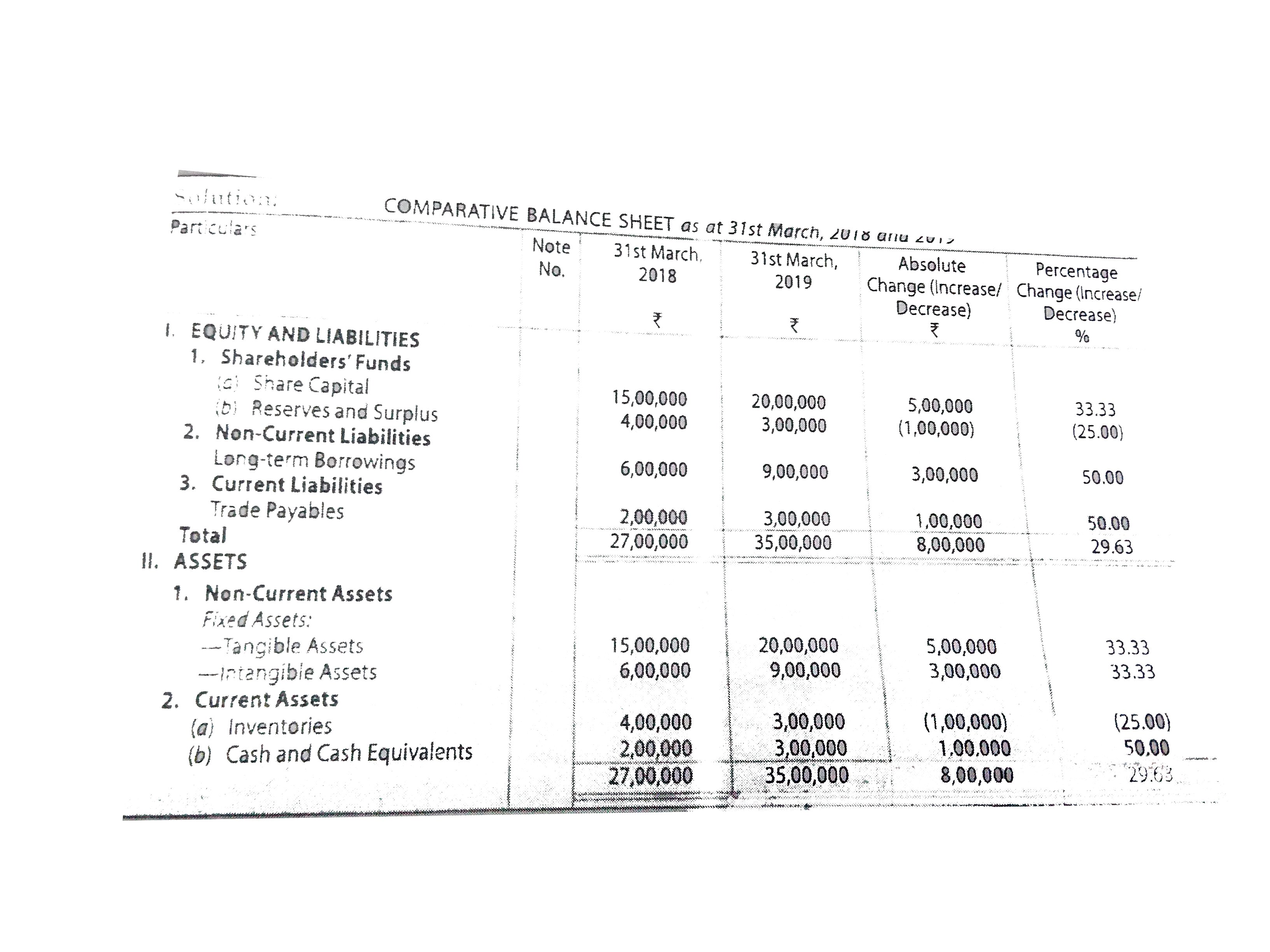 Debt to equity RATIO=`("LONG term DEBTS")/("shareholders's FUNDS")` `"For" 2017-18 =(RS 600000)/(Rs 1900000)=032:1, , "for" 2018-19=(Rs 900000)/(Rs 2300000)=0.39:1.` |
|
| 2094. |
from the above compute opeating ratio and operating profit ratio. Also explain the relationship between operting profit ratio and operating ratio. |
Answer» SOLUTION :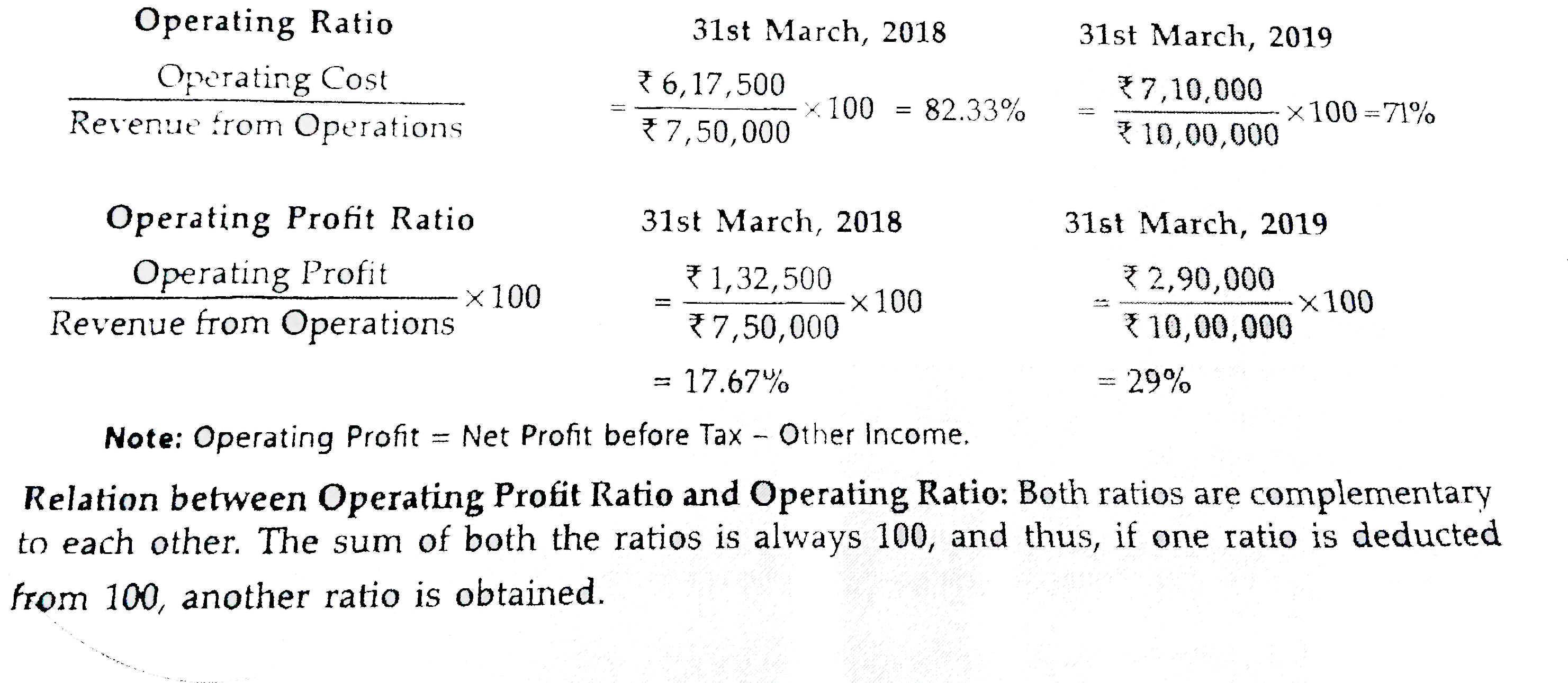
|
|
| 2095. |
From the above common size statement of profit and loss for th years ended 31st march , 2018 and 31st march 2019 compute gross profit ratio. |
Answer» SOLUTION :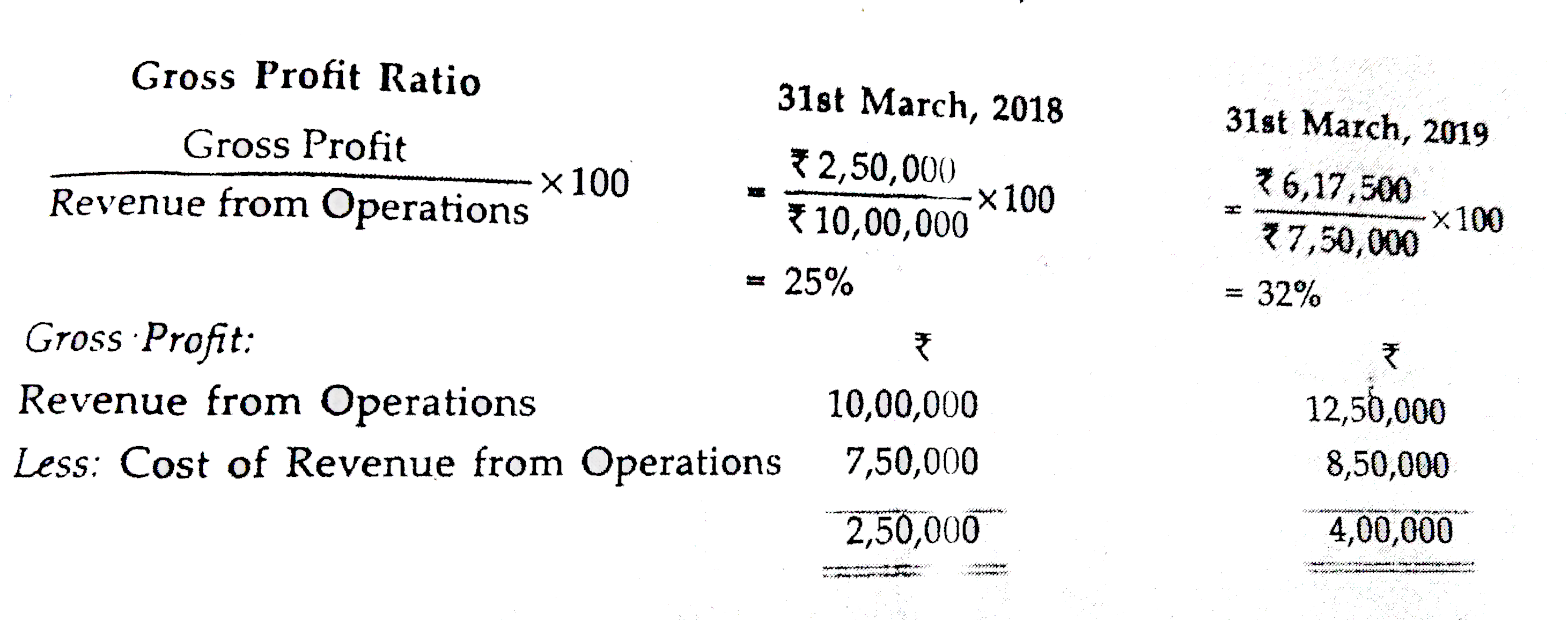
|
|
| 2096. |
From the above comparative statement of profit and loss for the year ended 31st march 2018 and 31st march 2019 compute net profit ratio. |
Answer» SOLUTION :
|
|
| 2097. |
Frank is admitted as partner in M/s Wood & Co., a partnership firm fo Garry and Terry. The firm has reserves of RS. 75,000 and accumulated profits of RS.1,00,000. At the time of admission Ashutosh, The Accountant, distributed the reserves and accumulated profits to Garry and Terry in their porfit-sharing ratio. Garry was of the opinion that they should not be distributed they will remain in the business and they can be distributed when a partner retries or the firm is dissolved. Do you agree with Garry's opinion? Give your reasons. |
| Answer» SOLUTION :No, GARRY is not correct because if the reserves and accumlated profits are distributed at the time of retirement or dissolution they will have to be distributed among all the partners including the new partner (Frank) in the profit-sharing ratio at the time of distribution. It will mean that the new partner (Frank) will also be GIVEN a share out of reserves and ACCUMULATED profits. It will not be correct because it PUTS Frank to advantage and Garry and Terry to disadvantage. | |
| 2098. |
From the above comparative statement of profit and loss for the year anded 31st march 2018 and 31st march 2019 compute operating ratio. |
Answer» SOLUTION :
|
|
| 2099. |
From the above common size balance sheet as at 31st march 2018 and 31st march 2019 compute current ratio , quick ratio , total assets to debt ration debt to equity ratio and proprietary ratio. |
Answer» Solution : SHAREHOLDERS' funds= share capital + Reserves and surplus: For the YEAR ended 31 st march2018=RS 500000+Rs 300000=Rs 80000, For the year ended 31 stmarch 2019 =Rs 1000000+Rs 200000=Rs 1200000. |
|
| 2100. |
(Forfeiture and Reissue of Shares). Complete the following Journal entries: |
Answer» SOLUTION :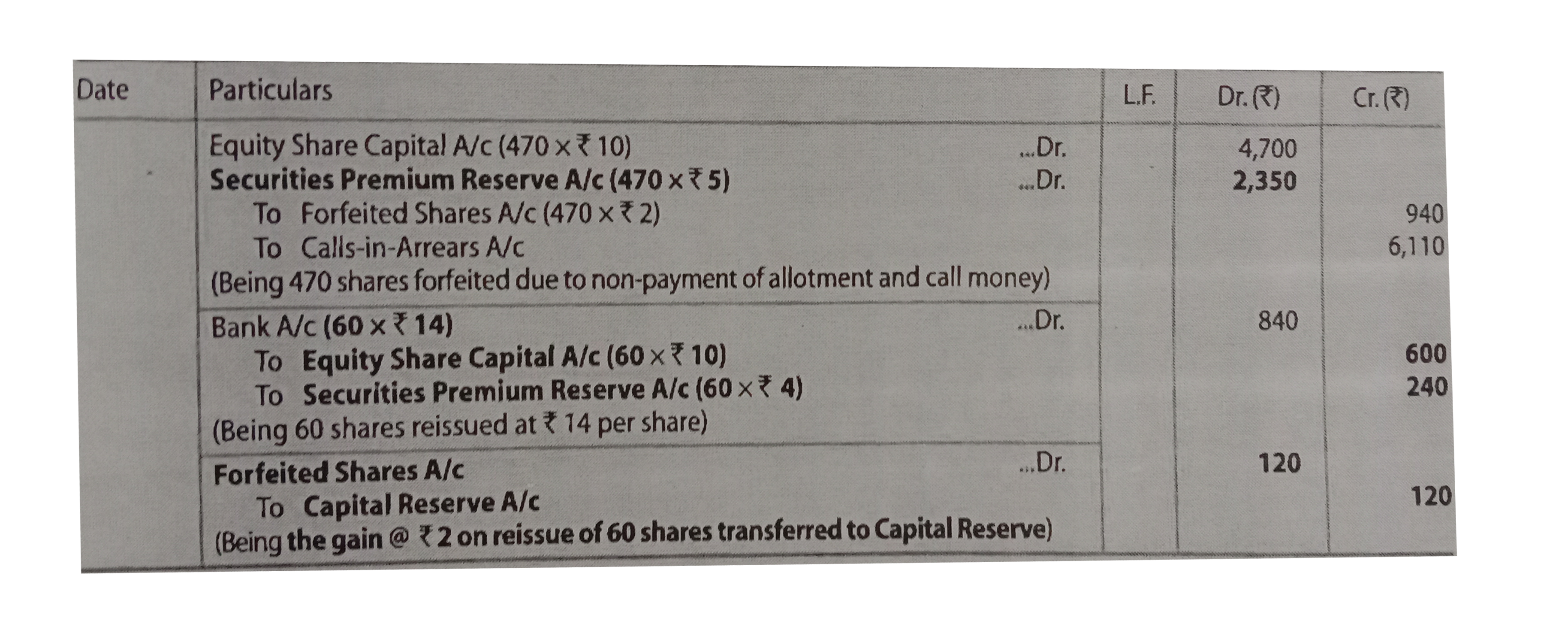
|
|